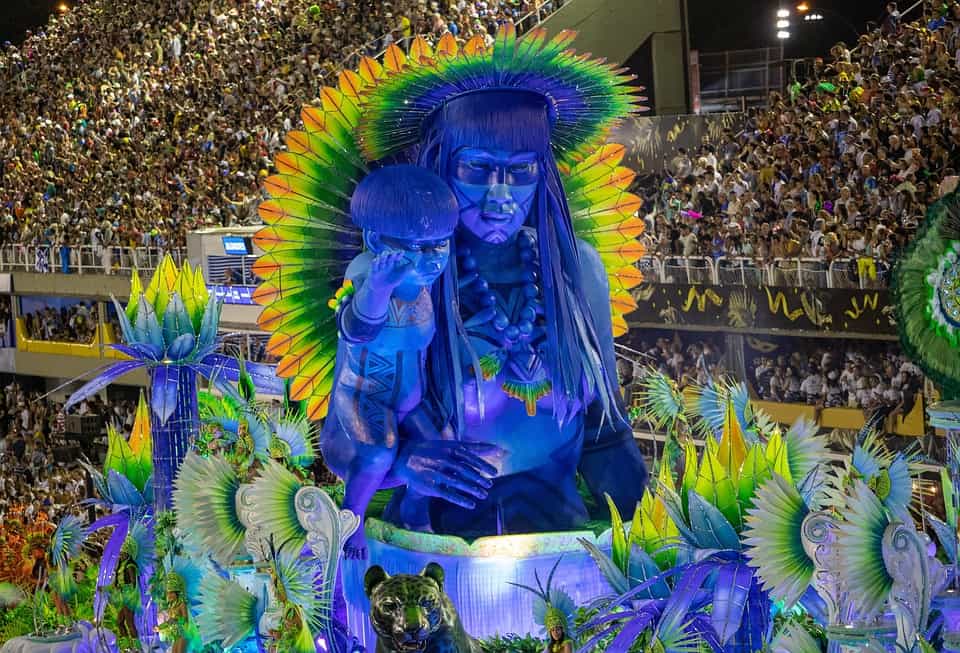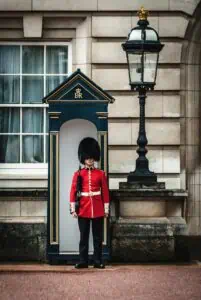Who hasn´t heard of it – the famous carnival in Rio de Janeiro (carnaval do Rio or carnaval carioca), the city of Sugar loaf, Copacabana and Ipanema. Interestingly, this event takes place at the same time as the Carnival in Cologne. These celebrations, which are among the largest and most colorful festivals in the world, start on the Friday before Ash Wednesday at 6:00 p.m. Loud and colorful, the parades marches through Rio into the early hours of the morning. In 1840 the first carnival was celebrated with polka and waltz before the samba was introduced. Today, the tourist office and the “Independent League of Samba Schools” (Liga Independente das Escolas de Samba do Rio de Janeiro, in short: LIESA) are responsible for the organization, coordination and marketing of this event.
Based on these 50 Brazilian samba schools (Escolas de Samba), the respective theme, the decoration of the colorfully decorated floats and the magnificent, breathtaking, costumes are coordinated. The rhythm, the interaction of the group and the choreography are oriented accordingly. The costs for these beautiful costumes (“fantasias”), which are only worn for a few hours, usually have to be financed by the participants themselves through hard work. Each samba school presents itself with one song only. The participating groups have between 65 and 82 minutes time in order to present themselves in a mutual competition. Anything that falls below or exceeds this time limit costs valuable points. The order will be decided by drawing lots. But watch out, the incorruptible jury judges the various performances in terms of costumes, rhythm and drum roll in harmony with the dance. This evaluation is very strict and every small mistake will be penalized with a point deduction. The highlight are Carnival Sunday and Monday. The twelve best samba schools in the first division, each with 3,000 to 5,000 participants, are each divided into 40 groups with 5 – 8 floats. On Ash Wednesday, the best samba school at the Rio Carnival will be awarded. A spectacular event with fireworks and victory celebrations. This will also be broadcasted on our television. These television rights and the income from record companies are a large source of income for the samba schools. Because here, as well, it is true that the time after Carnival 2023 is the time before Carnival 2024. From November onwards there will be busy celebrations and rehearsals again. Once more, thousands of helping hands are needed here. The carnival in Rio is mostly financed by private sponsors.
- The History of this special Carnival
This carnival was probably brought to Brazil by the Portuguese way back in the 17th century. Back then already, people celebrated the last few days before Lent began. At first, as a boisterous and degenerating hustle and bustle on the streets, this tradition blossomed from 1840 into a festival of the bourgeoisie. Events initially took place in posh ballrooms before the first samba school “Mangueira” was established in 1928. The first 1.7 km long processions took place just seven years later.
In 2006 the so-called Samba City was opened. Here the samba schools can build their magnificent floats. As a full-time job, the dancers and musicians prepare for this one big performance all year round.
While in other parts of Brazil the revival of the popular street carnival took place, in Rio de Janeiro the traditional salon and club carnivals and above all the organized parades of the samba schools continued to dominate.
The origin of the samba rhythms
The first carnival club was also founded by a Portuguese named, José Nogueira Paredes. It should be possible for every amateur in the club to play the same rhythm on a drum, so that a uniform sound could be created. In 1934, under the Getúlio Vargas government, the samba was declared being the official dance of the carnival.
- Sambódromo – centerpiece of the famous carnival
Since 1984, this festival has taken place in the carnival arena Sambódromo da Marquês de Sapucaí (hence it is often called Sapucaí for short). It is a huge grandstand street in the Estácio district. In February, this inconspicuous building is transformed into a boiling witch’s cauldron of light, color, music and dance. Responsible for this is the world-famous Brazilian architect and curve fan Oscar Niemeyer, who designed the plans for this. This “battle arena of the carnivalists” represents a 700-meter-long avenue, at the end of which an oversized gate is set as the goal. A boring concrete block in everyday life, this building comes to life for 4 nights in February and lets you forget the gray everyday life. Although this “arena” offers space for 88,500 carnival enthusiasts, it is actually already too small. However, it is a cultural heritage and therefore cannot be structurally modified in any way.
- Champions League of Samba Schools – Comparison to Soccer
The carnival shows many parallels to football. The teams are the competing samba schools, which also differ in the respective colors for the actors and the fans. The schools are divided into 4 leagues, the 12 best being in the Grupo Especial. The stadium is the previously described Sambódromo. The game strategy is the selected theme. This can be a character from history or literature, representing another country on earth, or a completely free motto. In terms of line-up, the most famous position is that of the queen of the rhythm section (rainha de bateria), who is dancing in front of the band and is often a celebrity from Brazil’s showbiz scene. Sometimes this is also a carnival couple.
- Brazilians – Cologne natives of the south
There is no Kölsch (famous beer) at the Sugar loaf, but same as in Cologne, the football and carnival events are being performed at the highest level. It is not for nothing that the Brazilians are considered being the Cologne natives of the south. On the Sugar Loaf as well as at the Rhine, the true carnival is the standard people’s carnival, which takes place on the streets and in small pubs and has very little to do with what you see on television. But television is an important image bearer. The prices during the carnival period in Cologne and Rio are comparably high. However, while traditional costumes apply in Cologne, less is more at the Copacabana, but with lots of glitter, feather boas, enormous jewels, Venetian masks and of course lots of seamlessly tanned skin. With the sub-equatorial summer prevailing there, it’s in fact no wonder. In contrast to Cologne, the parades are performed twice and no sweets are being thrown. The statue of Christ watches over Rio on the Corcovado, the famous cathedral of Cologne over Cologne.
“Tanze Samba mit mir, Samba, Samba die ganze Nacht. Tanze Samba mit mir, weil die Samba uns glücklich macht” has been a very famous German hit from 1978 sung by Tony Holiday.
Lots of naked skin, plenty of glitter, a lot of samba – even if the carnival in Rio de Janeiro seems so fascinating from afar. But like futebol, it’s not just about the show, but also about the love of the fans. About passion. About glory.





